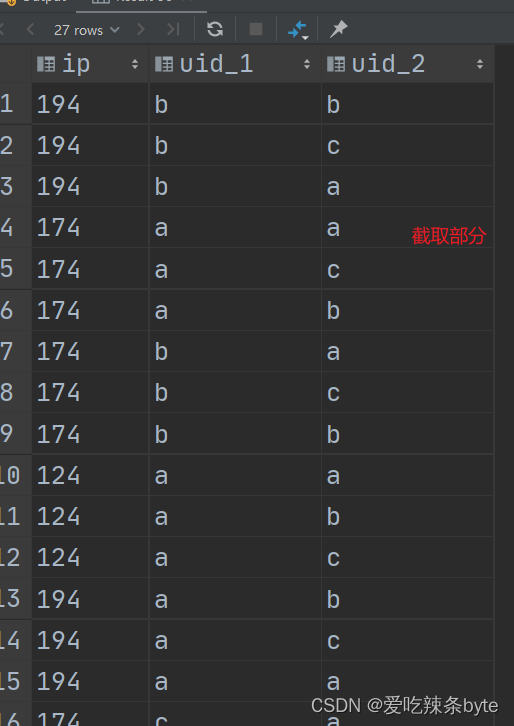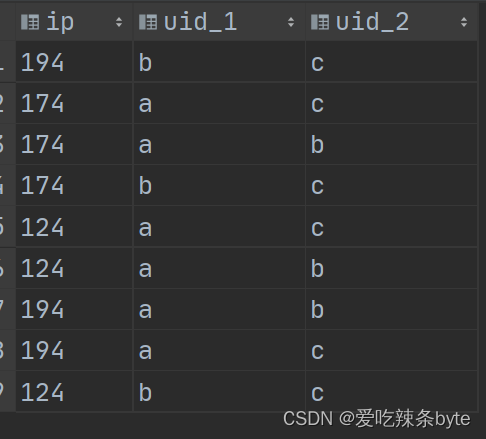注:参考文章:
SQL 之共同使用ip用户检测问题【自关联问题】-HQL面试题48【拼多多面试题】_hive sql 自关联-CSDN博客文章浏览阅读810次。0 问题描述create table log( uid char(10), ip char(15), time timestamp);insert into log valuesinsert into log values('a', '124', '2019-08-07 12:0:0'),('a', '124', '2019-08-07 13:0:0'),('b', '124', '2019-08-08 12:0:0'),('c', '124', '2019-0._hive sql 自关联https://blog.csdn.net/godlovedaniel/article/details/119858751
0 问题描述

1 数据准备
create table log
(uid string,ip string,login_time string
)row format delimited
fields terminated by '\t';insert into log values
('a', '124', '2019-08-07 12:00:00'),
('a', '124', '2019-08-07 13:00:00'),
('b', '124', '2019-08-08 12:00:00'),
('c', '124', '2019-08-09 12:00:00'),
('a', '174', '2019-08-10 12:00:00'),
('b', '174', '2019-08-11 12:00:00'),
('a', '194', '2019-08-12 12:00:00'),
('b', '194', '2019-08-13 13:00:00'),
('c', '174', '2019-08-14 12:00:00'),
('c', '194', '2019-08-15 12:00:00');2 数据分析
共同使用问题,一般此类题型都需要一对多,该问题的解决核心逻辑是自关联。
完整代码如下:
selectt3.uid_1, t3.uid_2
from (selectt1.ip,t1.uid as uid_1,t2.uid as uid_2from (select uid, ip from log group by uid, ip) t1join(select uid, ip from log group by uid, ip) t2where t1.ip = t2.ipand t1.uid < t2.uid) t3
group by t3.uid_1, t3.uid_2
having count(ip) >= 3;代码分析:
step1: 获取自关联的结果集
selectt1.ip,t1.uid as uid_1,t2.uid as uid_2
from (select uid, ip from log group by uid, ip) t1join(select uid, ip from log group by uid, ip) t2on t1.ip = t2.ip;step2: 由于数据会两两出现,所以a,b和 b,a实际上是一样的,需要过滤掉这部分重复数据,只需要选出 t1.uid < t2.uid,即过滤掉a,b这组数据。hive中不支持不等连接,故使用where语句
selectt1.ip,t1.uid as uid_1,t2.uid as uid_2
from (select uid, ip from log group by uid, ip) t1join (select uid, ip from log group by uid, ip) t2where t1.ip = t2.ip and t1.uid < t2.uid;step3:按照组合键分组,并过滤出符合条件的用户
selectt3.uid_1, t3.uid_2
from (selectt1.ip,t1.uid as uid_1,t2.uid as uid_2from (select uid, ip from log group by uid, ip) t1join(select uid, ip from log group by uid, ip) t2where t1.ip = t2.ipand t1.uid < t2.uid) t3
group by t3.uid_1, t3.uid_2
having count(ip) >= 3;3 小结
本案例题型属于:“共同xx”,例如:共同好友、互相认识、共同使用等。遇到这类关键字的时候,往往可以采用自关联的方式解决。(笛卡尔积:一对多;去重取一)




-触发器的创建和使用)





-数学函数在查询中的应用)


勒索病毒最新变种,攻击Linux平台)





】)


